Lenana School
Lenana School is a secondary school in Nairobi, Kenya. It was formed in 1949 by colonial governor Philip Euen Mitchell,[2] known then as the Duke of York School,[3] named after a British World War II King George V-class battleship (1939).[4] The actual bell from HMS Duke of York can still be seen mounted on a bell-shed at the front school parade ground between the school chapel and the hall. The first students were briefly housed at the then British colonial Governor's House which is the current State House[5][6] as they waited for the school's completion. The founding principal/headmaster was R. H. James.[7]
| Lenana School | |
|---|---|
 | |
| Location | |
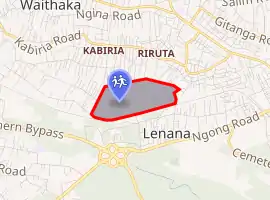
| |
Nairobi Kenya | |
| Coordinates | 1°18′0.957″S 36°43′41.775″E[1] |
| Information | |
| Type | National, Public |
| Motto | Nihil Praeter Optimum (Nothing But The Best) |
| Established | 1949 |
| Head teacher | William Kemei |
| Number of students | 1750 |
| Campus | Karen, Nairobi |
| Color(s) | Maroon, Grey and White |
| Alumni | The Laibon Society |
The school was renamed Lenana School in 1969 after the central person in the interaction of the Maasai with invading British imperialists and spiritual leader of the Maasai, Laibon[8] Lenana,[9] around the end of the 19th century through to the early 20th century. The first Kenyan headmaster (principal) of the school was Mr. James Kamunge. The referral to old students of the school changed from the phrase Old Yorkist to Laibons the latter being a title given to religious figures of the Maasai. A picture of Lenana painted by a student artist called Sam Madoka can be seen hanging next to the steps that lead to the 2nd floor of the administration block.
Lenana School currently has 1200 students. In 2006, it was ranked 26th best high school in Kenya based on Kenya Certificate of Secondary Education results.[10] Through the 1980s and into the 21st century, Lenana High School has maintained high academic standards ranking in the top 10 and top 20 respectively for many years in the 1980s. The current School Principal is Mr. William Kemei.[11]
School emblem
The white rose of York[12] (also called the Rose alba or rose argent[13]) which is the symbol of the House of York.[12] It also conjoins with the red rose to form the Tudor Rose.[14]
School motto
- Nihil Praeter Optimum, Latin for "Nothing But The Best".
Academics
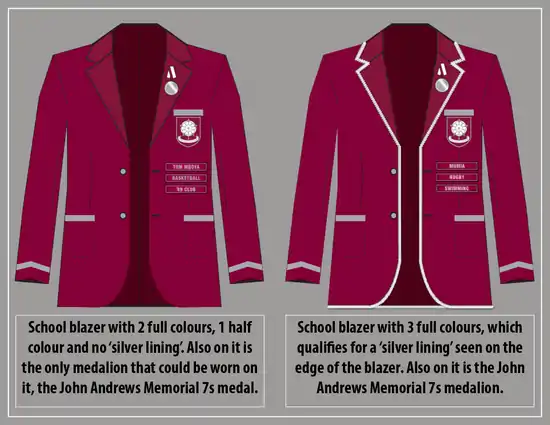
Lenana School is categorised as a National school, meaning it recruits students from all over the country who do well in the Kenya Certificate of Primary Education[15] (K.C.P.E) examination. Its nationwide recruitment objectives means that each entering class of fresh students is large and extremely diverse having representatives from all over the country. The classes offered run the full gamut of sciences and arts as well as life skills classes for the students thus inclined. The curriculum might be considered heavy on the sciences but equal attention is paid to providing the students with extensive humanities classes ensuring that all benefit from a well-rounded experience and maximum opportunities for life after high school. The school routinely has a good showing in the Kenya Certificate of Secondary Education[15] (KCSE) nationwide and is consistently ranked highly in its category of schools with large enrolment.[16][17]
Cadet training era
Lenana High School had a Combined Cadet Force (CCF)[18] training course of para-military standards in which interested students enrolled. The cadet course was started in the colonial era when Mau Mau activity was at its peak to provide basic training for conscription in the all-white Kenya Regiment and was mandatory for all students over 14 years of age. After the colonial era Lenana went on with the cadet course until it was stopped by the government after the unsuccessful 1982 coup d'état. The cadet section had uniforms, guns, ammunition, an armoury, a parade ground with adjacent stores and offices, an obstacle course and a shooting range. Wednesday afternoons were free of lessons for students so that the cadets could undertake their various training activities. The cadets took part in march pasts during various national days. They also used to be assigned sentry duty at the main gate and around the school at night. Successful cadets who passed out would be issued rank. The cadets, after completion of their form 6 education, could further their careers by joining the armed forces as officer cadets. When the cadet training course was shut down the government collected all the guns and ammunition from the armoury but left the cadet uniforms behind. Once every year until the late 1980s teachers would hold a supervised shooting competition. Most of the competitions took place during the school's Founders Day holiday that is celebrated on 28 January.
Sports

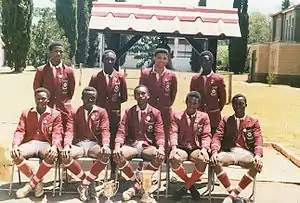
Their rugby is steeped in school tradition and has been a major part of the school's scenery since the school's inception in 1949. Back then the sport (and the school) was the reserve of the elite (predominantly white). Since then Lenana has been one of the four elite rugby schools,[19] winning many accolades, trophies, tournaments and being the only high school team ever to win a championship at club level (see Eric Shirley Shield 1977). The school is always represented in the Kenyan high schools premier rugby league – the Prescott Cup, Damu Pevu Shield, the National Rugby championship, the Blackrock Rugby Festival and all other tournaments open to high school rugby. The school also hosts the John Andrews Memorial 7-a-side Rugby Tournament, in honour of a former student. Many former students have gone on to represent the country on the national team in international tournaments as well as play professionally abroad.[19] The team is known as the 'Mean Maroon' and adorns the maroon jersey emblazoned with the white rose for home meets. A sampling of the rugby team's exploits can be found here.[20]
Colour awards
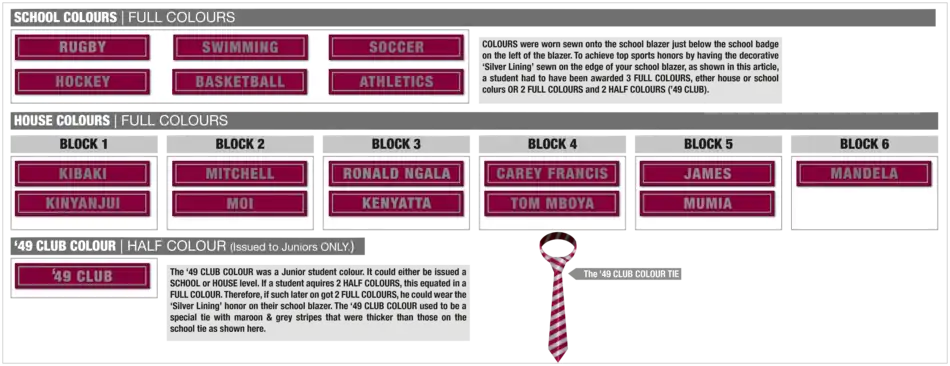
The school had an awards scheme where students were awarded school or house colours depending on the sport they excelled in. The colours consisted of a piece of maroon cloth approximately three inches in length, three-quarters on an inch in width and two-eighths of an inch thick. Its border and wording in the middle was embroidered with silver or white thread. There were two categories which are full and half colours. If someone was awarded a full colour in for example rugby the text on the colour would read RUGBY at the recipient would wear it on the left side of his school blazer just below the school badge. If a student acquired three full colours he was awarded a silver lining which was a thick silver or white thread that was sown all around the edge of his blazer. The half colours had the words 49 CLUB (49 being the year the school was founded) embroidered on them, two half colours equalled a full colour. Full colours bearing the name of the sport you excelled in could only be awarded at school level. If you were awarded full colours at the house level it could only indicate your house name and not the sport you received it for. House half colours also bore the name 49 CLUB. A silver lining was awarded by the principal. These details are listed in the Lenana School brand manual on its alumni website.[21]
Blocks/Houses
Lenana School was divided in dormitory blocks of 2 houses each. By 1988 there were 5 blocks which equaled 10 houses. Each house had students ranging from form 1 to form 6. Each of the block had its own dining hall where students take their meals. The dining halls fall under the jurisdiction of the school caterer. Of late, the block dining halls are headed by a council secretary head of block. It is the head of blocks dining halls that are appointed by the teachers after every successful council body elections. The four are under supervision of Boarding captain. Each house consisted of all the class streams i.e. form 1 to 6 (in the old system) and form 1 to 4 (in the new system). In the old system form 1 to 4 had approximately 18 students each per house and form 5 to 6 had approximately 10 to 12 students each per house. The house was divided into 2 categories, Form 1 to 3 were known as juniors and they had their own sporting leagues. Form 4 to 6 formed the seniors and they too had their separate leagues. When it came to school team selection this was open to both juniors and seniors. Form 1 to 4 students slept in dormitories. Some form 5's slept in the form 4 dorms while the rest and all form 6 students slept in studies either 2 sharing one or in singles e.g. the Head of House and his deputy and the sports prefect.
Each house was governed by a house master who consisted of a senior teacher living adjacent to the house. The student in charge of the house was known as a Head of House (HoH) and was a 6th form student. Assisting him run the house was a deputy head of house and about 5 or 6 other prefects all drawn from the form 6 students. The prefect roles were divided amongst the activities of the house and the most influential being the sports prefect. A new set of prefects was selected towards the end of the year (3rd term) from amongst the form 5 students. Each block of two houses shared a dining hall except for Block 1 and 4 where four houses shared one dining hall. Each house had one janitor who took care of the laundry services for the students and the general upkeep of the house.
The dormitories (houses) were named after famous explorers or persons related to historic events. Some house names changed over the course of time. This was done to acknowledge the changing times from the prior to independence and the many heroes involved in the independence movement in Kenya, as well as folk heroes. A few of the houses still retain their original names. Below are the house names listing the former name, current name and house colour where applicable. These details are listed in the Lenana School brand manual on its alumni website.[21]
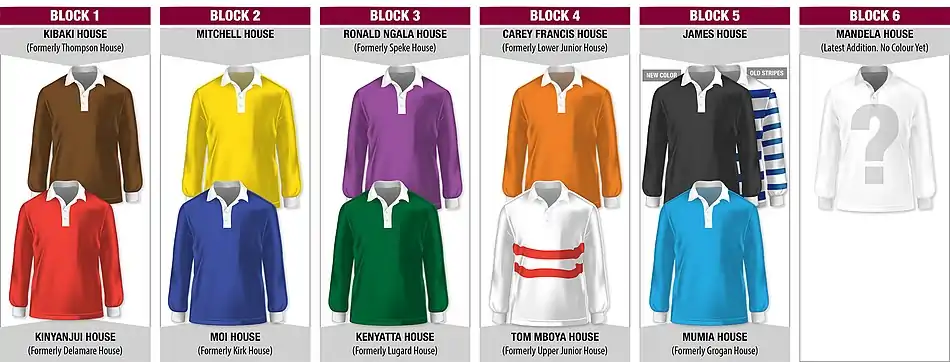
Block 1:
- Kibaki House (formerly Thompson House) – named after the 3rd President of Kenya Honorable Mr. Mwai Kibaki. The house color is brown.
- Kinyanjui House (formerly Delamere House) – named after Chief Kinyanjui who was a Kikuyu leader during the colonial era leading to the independence. The house color is red.
Block 2:
- Mitchell House – named after the colonial Governor of Kenya at the time when the school was founded, Sir Philip Euen Mitchell. The house color is yellow.
- Moi House (formerly Kirk House) – named after the second President of Kenya (retired), Hon. Daniel arap Moi. The house color is navy blue.
Block 3:
- Kenyatta House (formerly Lugard House) – named after the first President of the Republic of Kenya, Mzee Jomo Kenyatta. The house color is green.
- Ronald Ngala House (formerly Speke House) – named after pre-independence freedom hero and post-colonial politician who campaigned for the rights of the minority tribes, Ronald Ngala. The house color is purple.
Block 4:
- Carey Francis House (formerly Lower Junior House)- named after a colonial era Kenyan nationalist and education pioneer. Carey Francis is credited with establishing the Kenyan education system modelling it after the British public system and was the Principal at Maseno and Alliance High School (Kenya). The house color is orange.
- Tom Mboya House (formerly Upper Junior House) – named after a pre-independence political leader Tom Mboya. The house colours are white with two red stripes across and around the upper torso (These colours were sometimes won by England national teams in the same format and they are derived from the Flag of England).
Block 5:
- James House – named after the first Principal of the school, Mr. R. H. James. The house color is black (formerly their jersey had stripes of navy blue and white).
- Mumia House (formerly Grogan House) – named after Nabongo Mumia, who was a leader/king of the Luhya people during the colonial era. The house color is light blue.
- Mandela House-named after South Africa's president Nelson Mandela.
School sanatorium

The students and the staff and their families of Lenana School have a 'Level 2' classified sanatorium within the premises. It is equipped with a doctor/medical officer/nurse clinic and both general and private wards for in-patient treatment. The School, through the sanatorium staff and facilities, preserves the health and nutritional status of its residents as well as provides basic medical treatment and stabilisation in cases of emergencies. The School Sanatorium also provides medical counselling services. The School Sanatorium treats about 40 students per day. It has five (5) rooms for its out-patient activities, and six (6) rooms that can accommodate 10 students for in-patient treatment. It has some basic medical equipment and a budget for basic drugs and medicines. In 2019, the Ministry of Health (Kenya) (MoH) designated the Lenana School Sanatorium a MoH Level Two (2)[22] Health Clinic, which assists it in obtaining National Hospital Insurance Fund (NHIF) funded services. The MoH requires that the School undertakes a Quality Improvement Programme for the School Sanatorium, i.e. digitization of its treatment records; means of communicating; and an upgrade of medical equipment, testing equipment, mosquito nets, etc.
Notable alumni
- John Dunt, former Royal Navy officer
- Geoffrey Kent, founder, chairman, and CEO of Abercrombie & Kent
- Richard Leakey
- John Sibi-Okumu
- Binyavanga Wainaina
- Joseph Mucheru, Kenyan Cabinet Secretary for ICT
References
- "Google Maps". Maps.google.com. Retrieved 15 March 2020.
- https://www.tuko.co.ke/317547-lenana-school-fee-structure-location-contacts-performance.html
- "Duke of York School, Nairobi, Kenya".
- "HMS Duke of York, British battleship, WW2". Naval-history.net. Retrieved 15 March 2020.
- pm, Vincent Kejitan on 22 June 2017-7:18. "Kenyan Secondary School That Used State House as a Dormitory". Kenyans.co.ke.
- App, Daily Nation. "When Lenana boys lived in State House". mobile.nation.co.ke.
- http://www.mccrow.org.uk/eastafrica/duke%20of%20york%20school/Duke%20of%20York%20School.html
- "Maasai religion and beliefs - Traditional Music & Cultures of Kenya". www.bluegecko.org.
- Kareithi, Amos. "The life and times of paramount chief Lenana". The Standard.
- "News". Optimum Kenya Trust.
- "House of York | English family". Encyclopedia Britannica.
- "A GLOSSARY OF TERMS USED IN HERALDRY by JAMES PARKER". www.heraldsnet.org.
- "Red roses and white: A brief history of the Tudor Rose". 3 November 2015.
- "The history of the Kenyan education system". Daily Nation.
- http://elimu.education.go.ke/KCSE/natschdisp.asp
- http://elimu.education.go.ke/KCSE/schtop450disp.asp
- "Duke of York School".
- "A Review of Kenyan Rugby". Archived from the original on 24 October 2007. Retrieved 15 March 2020.
- "AlumniMart.com". Archived from the original on 24 April 2009. Retrieved 15 March 2020.
- https://mylaibon.com
- "Health Care System in Kenya" (PDF). www.usaidassist.org. Retrieved 15 March 2020.